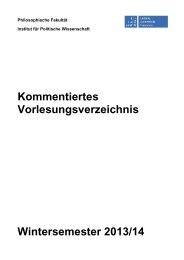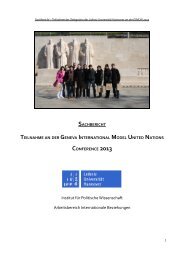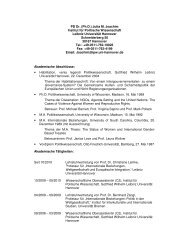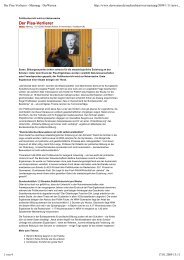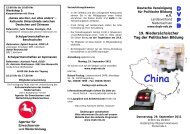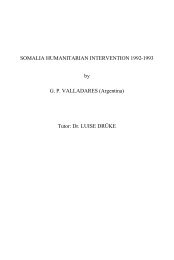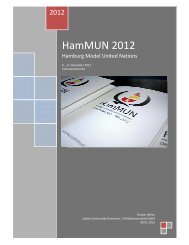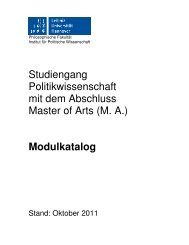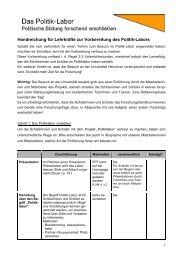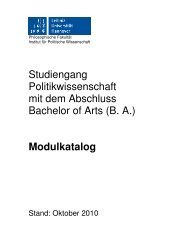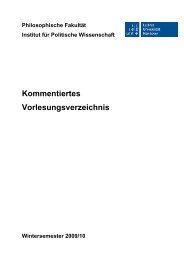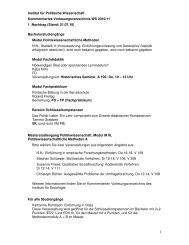Preventive Action for Refugee Producing Situations
Preventive Action for Refugee Producing Situations
Preventive Action for Refugee Producing Situations
Create successful ePaper yourself
Turn your PDF publications into a flip-book with our unique Google optimized e-Paper software.
102 Chapter 3<br />
return of nonrefugees, provided that the return is voluntary and that the<br />
international community makes available economic assistance. 225 Vietnam's<br />
change of policy now justifies that a screening mechanism might finally be<br />
set up, and mat the return of nonrefugees might be carried out by UNHCR<br />
under international monitoring system and with international assistance. This<br />
assistance to Vietnam should, however, not only be directed toward the<br />
reintegration of returnees but should also cover economically deprived areas<br />
in Vietnam from which people have been leaving. Vietnam's change of<br />
policy appears also to include a softening of its application of article 89 of its<br />
penal code, which deals with the punishment of returnees <strong>for</strong> having left the<br />
country in a clandestine manner. 226 With these new developments, screening<br />
is now more likely than ever be<strong>for</strong>e; this will no doubt have an impact on an<br />
individual's decision whether or not to attempt escape from Vietnam in the<br />
future.<br />
4. Prospects of rescue at sea<br />
The chances of being rescued at sea by international vessels may have influenced<br />
people's decisions to leave Vietnam - particularly in the period<br />
between the Geneva Conference in July 1979 and the mid-1980s, through<br />
which world public opinion was focused on their plight. From September<br />
1979, on several mercy ships were operating in the South China Sea with the<br />
purpose of rescuing Vietnamese boat people in distress. 227 Although some of<br />
these ships had great difficulties in unloading the human cargo they had<br />
rescued 228 until 1979, when UNHCR started to make special ar-<br />
_______________________<br />
225 Nguyen Xuan Oanh, Lecture, Harvard University, 3 October 1988.<br />
226 "Hanoi no longer brands as traitors and criminals those who have applied to leave<br />
the country legally, Sergio Viera de Mello, who directs the ef<strong>for</strong>ts of the United<br />
Nations High Commissioner <strong>for</strong> <strong>Refugee</strong>s in Asia, said in an interview on returning<br />
from Vietnam." "Hanoi seen willing to take back people," Boston Globe, 2 August<br />
1988.<br />
227 Akuna was operated by Food <strong>for</strong> the Hungry; Cap Anamur by the German<br />
Committee 'A Ship <strong>for</strong> Vietnam;' lie de Lumiere by the French Committee 'Un<br />
Bateau pour le Vietnam'; Lysekil by the Egil Nansen Committee of Norway; and<br />
Seasweep by World Vision International.<br />
228 Among the countries in the Asian region, only Singapore, the Philippines, Hong<br />
Kong, and Japan would accept to disembark refugees rescued at sea. Singapore,<br />
however, would not allow any landings of direct arrivals from Vietnam, and from<br />
October 1978 would admit refugees on a resettlement guarantee from a third<br />
country that the entire group would have left Singapore within three months. The<br />
Analytical Discussion 103<br />
rangements to allow speedy procedures <strong>for</strong> disembarkation, 229 I gathered<br />
evidence from many refugees in Singapore between July 1979 and June 1981<br />
that they had simply taken the opportunity to leave, at times with limited<br />
supplies and unseaworthy boats, in the hope of eventual rescue.<br />
Undoubtedly, the mercy ship rescue operation, as well as the remarkable<br />
sacrifices some commercial ships underwent to rescue boat people, contributed<br />
to saving thousands of lives of people in distress after arduous encounters with<br />
Vietnamese patrols, ruthless pirates, and untold other difficulties. Even with the<br />
rescue operations, we are uncertain now many drowned and never reached safe<br />
shores; 230 without the rescue attempts, the loss and damage to human life<br />
would have unquestionabbly been much higher.<br />
Returning to rescue at sea as a pull factor: Even though I do not suggest that<br />
rescue operations should be stopped, a combination of approaches may provide<br />
a better incentive <strong>for</strong> Vietnam itself to take action in the situation. The South<br />
China Sea is one of the busiest shipping lanes in the world. There<strong>for</strong>e,<br />
commercial vessels will keep navigating in this area. Through the International<br />
Maritime Organization, shipping agents, ship owners, and ship captains may<br />
take note of the continuing need <strong>for</strong><br />
landing of Vietnamese rescued by mercy ships was only feasible under exceptional<br />
circumstances.<br />
229 The Disembarkation Resettlement Offer (DISERO), was a pool of visas, originally<br />
negotiated and established by the writer on the basis of 200 visas made available by<br />
the Government of Belgium, "to resettle Vietnamese refugees should they be rescued<br />
by a vessel flying a flag of convenience or of a country which can not reasonably be<br />
expected to resettle refugees." The Norwegian mercy ship Lysekil, on its first rescue<br />
tour, returned to Singapore in July 1979 returned with 259 rescued people on board.<br />
The Norwegian Government appealed to other countries to absorb rescuces from<br />
subsequent mercy voyages. However, Lysekil stopped rescues and switched to<br />
transporting food and other supplies <strong>for</strong> refugees in the region, so that the 200 visas<br />
that the Belgian Government provided <strong>for</strong> this purpose could be 'redeployed.' As a<br />
result, more than six hundred people could be safely brought to land with this "safety<br />
valve" by which Belgium gave a guarantee <strong>for</strong> resettlement to the authorities of<br />
Singapore. In resettling the refugees elsewhere, especially under the family<br />
reunification program, these visas were, in fact, used several times. Subsequently<br />
UNHCR Headquarters replenished this visa pool and added an additional mechanism,<br />
the Rescue at Sea Resettlement Offer (RASRO). During 1986 2,591 refugees were<br />
rescued at sea. Some 1,249 benefited from the RASRO scheme, and a further 292<br />
persons were disembarked under the DISERO Scheme. UN doc. A/Ac. 967 694, 3<br />
August 1987: Note on International Protection, submitted by the High Commissioner,<br />
p. 11.<br />
230 According to UNHCR's estimates, as many as 250,000 people may have drowned.



